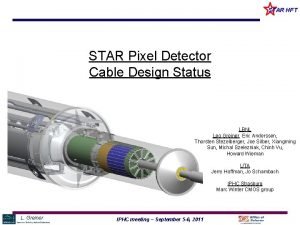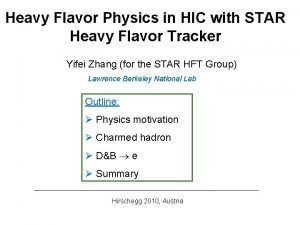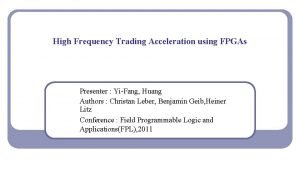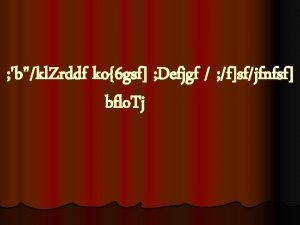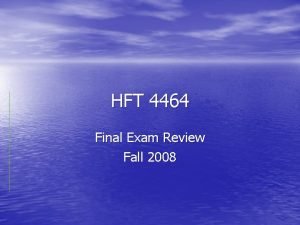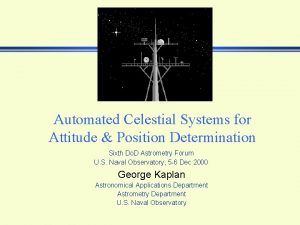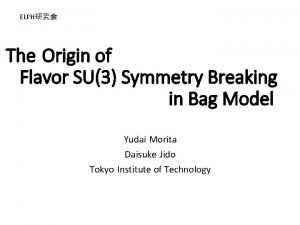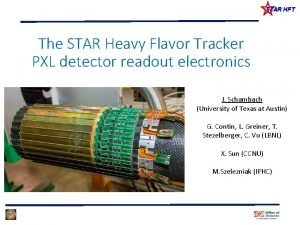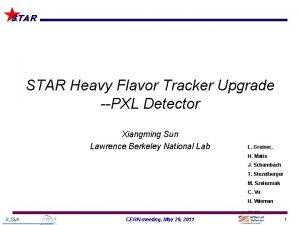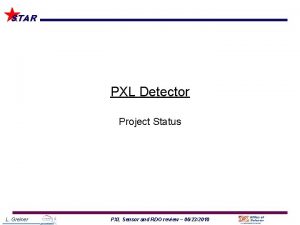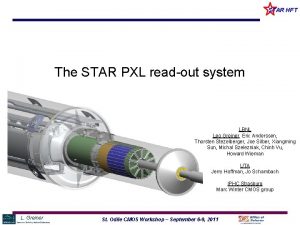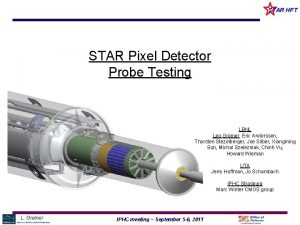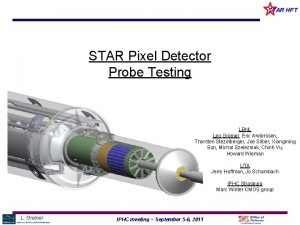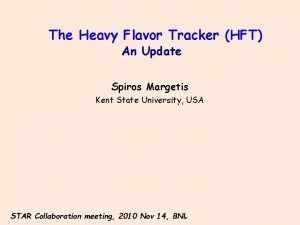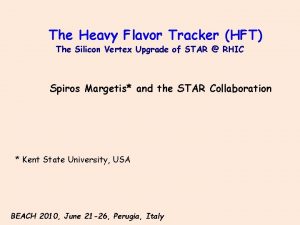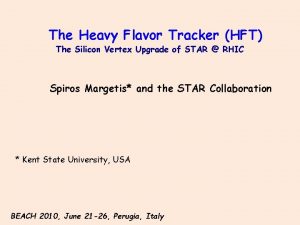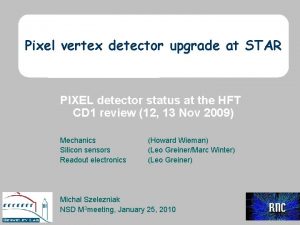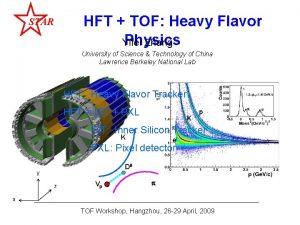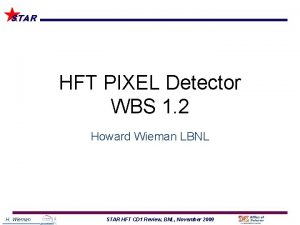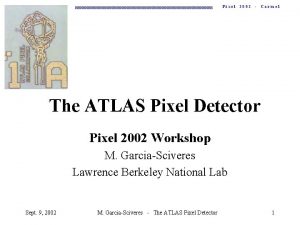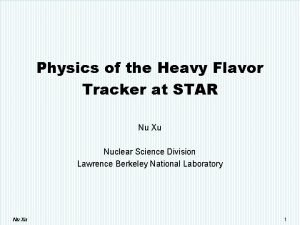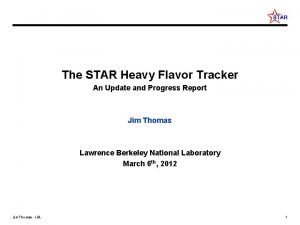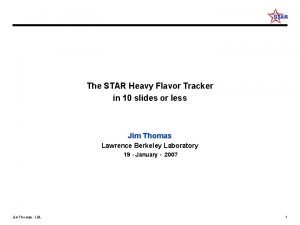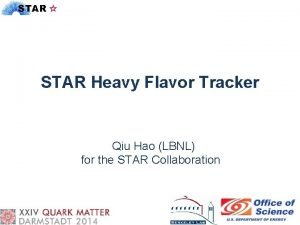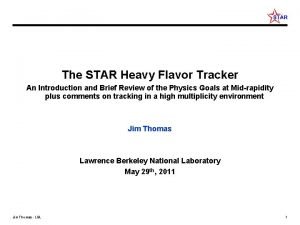Heavy Flavor Tracker Pixel Detector HFT PXL STAR





















- Slides: 21

Heavy Flavor Tracker Pixel Detector (HFT PXL) STAR HFT Howard Wieman LBNL for HFT collaboration First operational vertex detector based on Monolithic Active Pixel Sensors (MAPS) or also called CMOS Pixel Sensors (CPS) CPS developed by PICSEL group of IPHC-Strasbourg (Marc Winter et al. ) 1

STAR HFT Outline • Introduction, description of HFT PXL and purpose • Requirements and fit to MAPS technology • Credit the IPHC group that developed the detector chip • Briefly cover how the chip works • What we can expect in detector chip development and how it can benefit STAR 2

HFT PXL in STAR Inner Detector Upgrades STAR HFT TPC – Time Projection Chamber (main tracking detector in STAR) HFT – Heavy Flavor Tracker l SSD – Silicon Strip Detector l l IST – Inner Silicon Tracker l l TPC ~1 mm SSD ~300µm IST ~250µm PXL r = 14 cm PXL – Pixel Detector l We track inward from the TPC with graded resolution: r = 22 cm r = 2. 8, 8 cm Direct topological reconstruction of Charm <30µm vertex 3

PXL Detector Design STAR HFT Mechanical support with kinematic mounts (insertion side) carbon fiber sector tubes (260 µm thick) Insertion from one side 2 layers 5 sectors / half (10 sectors total) 4 ladders/sector 5 ladder weight 11. 2 gm Ladder with 10 MAPS sensors (approx. 2× 2 cm each) Aluminum conductor Ladder Flex Cable 20 cm 4

PXL Detector Design Characteristics DCA Pointing resolution (12* 24 Ge. V/p c) m Layers Layer 1 at 2. 8 cm radius Layer 2 at 8 cm radius Pixel size 20. 7 m X 20. 7 m Hit resolution 3. 7 m (6 m geometric) Position stability 6 m rms (20 m envelope) Radiation length first layer X/X 0 = 0. 39% (Al conductor cable) Number of pixels 356 M Integration time (affects pileup) 185. 6 s Radiation environment 20 to 90 k. Rad / year 2*1011 to 1012 1 Me. V n eq/cm 2 Rapid detector replacement ~ 1 day 356 M pixels on ~0. 16 m 2 of Silicon * Simple geometric component, cluster centriod fitting gives factor of ~1. 7 better. STAR HFT

Au + Au 200 Ge. V central collision, ± 1 d. N/d 650 STAR HFT The challenge X 160 100 µm human hair for scale Inner layer HFT PXL detector D meson decay c 130 µm 6

Requirement: The detector should resolve vertex locations as precisely as possible. Which means: 1. Thin, reduced multiple coulomb scattering 2. Small high position resolution pixels 3. Stable, limited vibration and low position drift 4. Inner layer close to the beam STAR HFT Additional requirements: 5. Fast, to reduce pileup which compromises hit to track association 6. Radiation hard MAPS are particularly well suited to satisfying item 1 because they can be thinned to 50 µm, they don’t need an additional silicon readout layer, and they are relatively low power and can therefore be cooled with air, avoiding more massive cooling systems. MAPS satisfy item 2, they have smaller pixels than alternative technologies. This is more important than one might think and will be addressed in more detail in the next slide. MAPS are limited in satisfying items 5 and 6, pileup and radiation hardness. This is where one can expect improvements in the future. Some of these expectations will be covered. 7

The advantage of improved spatial resolution and reduced radiation length STAR HFT Simulation results Pixel size radiation 0. 5 Ge. V D 0 length relative number of events 1. 5 Ge. V D 0 relative number of events hybrid 50 m x 450 m 1. 4% 36 200 MAPS 27 m x 27 m 0. 6% 1 1 S + B parameters used in the simulation, but actual HFT PXL parameters are smaller 8

STAR HFT Marc Winter’s IPHC MAPS Team in Strasbourg: Designed and developed the STAR PXL detector chip Design, testing, integration 2000: 3 FTE 2014: ~25 -30 FTE ~ 20 Ph. D students involved in the development Worked closely with LBNL with significant interaction with Leo Greiner and his team adjusting design to provide diagnostic and testing features. Arranged for Michal Szelezniak to move to LBNL help with integration of MAPS in our project Their graduating students have moved on and done well at other detector design centers: Grzegorz Deptuch, group leader at Fermi Lab from CPIX 14 15 -17 September 2014, University of Bonn, IPHC christine. hu@in 2 p 3. fr Institut Pluridisciplinaire Hubert Curien (IPHC) Renato Turchetta, group leader at Rutherford Appleton Lab 9

Some features of the CPS in HFT PXL charge reflection where p doping changes generating an E field basic sensing diode in traditional CPS • Ion ionizing radiation generates electron hole pairs • Electrons in the depleted region drift (rapid transfer to the n well) • Electrons in the non depleted pepi feel no field and randomly diffuse (a slow process) before the reach a depleted region and are captured • On the detection time scale the diode is electrically isolated so that the voltage on the diode is a step function with ∆V = ∆Q/C. This voltage change is recorded through Correlated Double Sampling (CDS) STAR HFT

Some features of the CPS in HFT PXL STAR HFT The PXL chip has an amplifier and CDS built into each PXL. This allows a single discriminator be used to successively to record hits for multiple pixels. Some added comments while this picture is up: Over the development time of the PXL detector, improvements in the CMOS available to IPHC lead to important improvements. The available p-epi layer went from 10 cm to 400 cm, that is the p-epi is less heavily doped and consequently the depletion region thickens. This improves the signal to noise because C is smaller resulting in better signal to noise (remember ∆V = ∆Q/C). This and the reduced charge collection time improves radiation hardness. Reducing the charge collection time means less probability for electrons to be trapped on the radiation induced defects. Slow electrons in the diffusion region are more likely to be trapped than the fast electrons in the depleted drift region. 11

STAR HFT Rolling shutter readout • A row is selected, and each pixel in the row is connected to it’s column • Once the column line has settled the discriminator at the end of the column identifies whether the pixel contained a hit and then the row counter advances to the next row to repeat • A hit is recorded for any particle that passes between interrogations, so cycling faster reduces pileup discriminator at the end of each column readout time of STAR PXL chip: 186 s With this scheme the frame time or readout frequency is limited by the power vs time trade off of charging the long column lines Rows: 928 connecting the pixel to the discriminator. It is for this reason that Columns: 960 many groups are working on methods to include the discriminator within the pixel. Having a discriminator in each pixel can lead to a 12 significant reduction in the readout time, more on this later.

The current version of the HFT PXL detector is cutting edge and will allow for the first time topological reconstruction of Ds in a heavy ion environment. STAR HFT But, there is room for improvement. A much shorter read out time would be big for the following two reasons. • Reduced pileup to improve hit to track association and allow operation at higher luminosities • Allow use of PXL data in the trigger definition Next, what we can expect from improved technology 13

One example, a faster readout based on the token approach. STAR HFT Readout does not require an external scan of all the pixels pre amp discr shaper latch token initiator latch holds for 2 -3 µs (trigger latency time) trigger token cell Each pixel has a preamp, shaper, discriminator latch and token cell. The discriminator is active full time. row address generator Token cells have combinatorial logic, zippers to the next set latch in the time that the previous latched pixel address is generated and sent off chip. column address generator tokens, a concept used in hybrid technology, FPIX, 1999, Fermi Lab • If a pixel is hit the latch remains on for a few µs • If a trigger arrives during that time then the latch is held active • The token stops at the next active pixel and the pixel connects to the address generators. Since this is a logic connection settling time is short compared to an analogue connection. Plus only hit pixels get connected to the perimeter. This is the big time saver over the current HFT PXL chip. • The token is released and ripples through to next active pixel. The pixel to pixel ripple through is very fast since it is local logic not requiring a clock. 14

The main point of the last slide was to show that with a discriminator on each pixel there are ways to read out a chip without interrogating each pixel from the perimeter of the chip and that greatly speeds up the readout of the chip. STAR HFT Walter Snoeys and Luciano at CERN are developing the ALPIDE chip which has an amplifier and discriminator on each pixel and also uses asynchronous (combinatorial) readout logic. It accomplishes the same thing as the token approach, namely only hit pixels get clocked out to the periphery. See: Marc Winter’s talk: “CMOS Pixel Sensors Developed for the ALICE-ITS Upgrade” Workshop on CMOS Active Pixel Sensors for Particle Tracking (CPIX 14) 15 -17 September 2014, University of Bonn http: //indico. cern. ch/event/309449/session/20/contribution/9/material/ slides/ also: The ALICE Collaboration, J. Phys. G: Nucl. Part. Phys. 41 (2014) 087002, 2. 5. 4 ALPIDE, p. 22 15

Requirements for an on pixel discriminator STAR HFT • Need more signal for operation with a simple on pixel discriminator. This is required to overcome variations in discriminator thresholds. Two options being studied 1. Deep p-well so that both p channel and n channel FETs can be placed in the pixel. Better amplifies that can provide a larger signal require both p and n channel FETs. With traditional CMOS technology only n channel FETs can be used. 2. 3 D technology where the amplifiers and other electronics are in one layer and the sensor silicon is a separate layer directly bonded and coupled to the electronics layer. This is in the same spirit as earlier hybrid pixel designs, but the coupling technology provides higher pixel densities than can be achieved with traditional bump bonding. By having a separate sensor silicon one can use a thicker high resistive silicon and full depletion to produce a larger signal. Also, both NMOS and PMOS is available for the Read Out Integrated Circuit (ROIC). Fig. from Marc Winter’s talk: “CMOS Pixel Sensors Developed for the ALICE-ITS Upgrade” Workshop on CMOS Active Pixel Sensors for Particle Tracking (CPIX 14) 15 -17 September 2014, University of Bonn Fig. from Grzegorz Deptuch’s talk: “MAPS are for amateurs, professionals do 3 D” Workshop on CMOS Active Pixel Sensors for Particle Tracking (CPIX 14) 15 -17 September 2014, 16 University of Bonn

In conclusion the HFT PXL detector installed in STAR is providing excellent pointing resolution X Cosmic ray result Excellent half to half pointing, sub 30 m But after half to half alignment which was required to correct poor reproducibility of kinematic mount seating X X STAR HFT X Xs shows how hits are selected for projective distance of closest approach comparison AND 17

STAR HFT We are well positioned with our quick change mechanics to take advantage of expected new pixel technologies that will both allow operation at increased luminosities and use of pixel information in trigger decisions. 18

STAR HFT backup 19

STAR HFT Deptuch chip: 400 m. W or 100 m. W/cm 2 ALPIDE: 50 n. W/pixel or 48 m. W for 9802 pixels 20

STAR HFT Reduce pileup and improve hit to track association Roughly where we are now with the HFT PXL at current luminosity combined position uncertainty between a track and a hit on the inner layer hit density on the inner layer, scales with luminosity and integration time probability of correctly associating the hit with the track Pileup hit density will be increasing with luminosity further compromising the ability to correctly associate hits with tracks. The solution is reduced readout time/integration time for accumulating pileup hits. 21
 Hft cable tracker
Hft cable tracker Blackboard pxl
Blackboard pxl Charm mesom
Charm mesom Myrrh is mine its bitter perfume
Myrrh is mine its bitter perfume Ratey method
Ratey method Financial accounting final exam
Financial accounting final exam Hft accounting
Hft accounting Fpga high frequency trading
Fpga high frequency trading Lsf hft
Lsf hft Hft 2220
Hft 2220 Hft 3431
Hft 3431 Hft 4464
Hft 4464 Sr 71 star tracker
Sr 71 star tracker Fccla star stands for
Fccla star stands for A* algorithm and ao* algorithm
A* algorithm and ao* algorithm Su(3) flavor symmetry
Su(3) flavor symmetry Contoh komponen non gizi
Contoh komponen non gizi Foodstuffs aroma
Foodstuffs aroma How does salt lose its flavor
How does salt lose its flavor Fema gras certification
Fema gras certification Mc flavor fries
Mc flavor fries Komponen non gizi jenis zat warna dan flavor terdiri dari
Komponen non gizi jenis zat warna dan flavor terdiri dari
